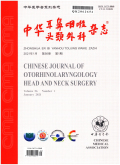无创通气在阻塞性睡眠呼吸暂停低通气综合征患儿外科治疗中的应用
Use of noninvasive ventilation in surgical treatment of obstructive sleep apnea hypopnea syndrome in children
摘要目的 探讨无创通气在阻塞性睡眠呼吸暂停低通气综合征(OSAHS)患儿外科治疗中的应用.方法 2002年5月至2007年12月经多道睡眠监测(PSG)诊断为OSAHS的11例腺样体扁桃体肥大患儿和7例曾行腺样体扁桃体切除术后的患儿应用无创通气治疗,其中男17例,女1例;年龄1~11岁,中位数3.8岁.所有患儿应用无创通气治疗后再次行PSG.统计数据符合正态分布以x-±s表示,治疗前后的呼吸参数变化采用配对t检验.结果 11例术前使用鼻持续正压通气(nasal continuous positive airway pressuren,nCPAP)患儿,术中无麻醉并发症及术后拔管困难,其中6例腺样体扁桃体切除术后呼吸暂停低通气指数(AHI)<10次/h,最低脉氧饱和度(pulse oxygen saturation,SpO_2)>0.85,无需再行无创通气治疗;5例术后围手术期仍使用nCPAP治疗.1例本院患儿及7例外院术后疗效不佳患儿术后长期使用nCPAP治疗.经nCPAP治疗前和治疗时的睡眠呼吸暂停低通气指数、最低SpO_2及SpO_2低于0.90占睡眠时间的百分比分别为(4.7±3.9)次/h、0.867±0.069和0.3%±0.5%,与治疗前(77.6±39.8)次/h、0.535±0.151和46.9%±34.5%相比有显著改善(t值分别为7.77、-11.62、5.69,P值均<0.001).结论 无创通气是重度OSAHS患儿围手术期可选择的一种有效治疗方法,手术后仍有阻塞性睡眠呼吸暂停的患儿,nCPAP治疗效果良好.对家庭nCPAP治疗的患儿要定期进行随访.
更多相关知识
abstractsObjective To study the efficacy of noninvasive ventilation in the surgical treatment of obstructive sleep apnea hypopnea syndrome(OSAHS)in children.Methods Since 2002.5-2007.12,eleven children with adenotonsillar hypertrophy and seven children with post-adenoidtonsillectomy were enrolled in the study.All children were confirmed as OSAHS by polysomnography(PSG)or portable oximetry monitor.Male:female ratio was 17:1.The age ranged from 1 to 11 years(median 3.8 years).The noninvasive ventilation treatment was carried out in all children pre-or postoperatively.PSG was the index for therapy effect.SPSS 11.5 was used to analyse the data.The parameters,x±s,were normal distribution,and paired t-test for significancy.A P valBe of<0.05 was considered statistically significant.Results Six children after adenotosillectomy,with AHI<10/h,lowest pulse oxygen saturation(SpO_2)>0.85,did not need nasal continuous positive airway pressure(nCPAP).Eleven patients with preoperative nCPAP,did not have anesthesia comlications.Post-nCPAP,apnea and hypopnea index AHI(4.7±3.9)/h,the lowest SpO_2 0.867±0.069,and the average time percents SpO_2<0.90 during sleep(0.3%±0.5%)improved significantly compared to pre-nasal continuous positive airway pressurecn(nCPAP),which were(77.6±39.8)/h,(0.535±0.151)and(46.9%±34.5%),t value were 7.77,-11.62,5.69,P<0.001.Conclusions Noninvasive ventilation is an effective treatment for severe OSAHS children pre-or postoperation.nCPAP could be used to treat children still with OSAHS after adenotonsillectomy,and also an effective treatment to the ones who had surgical contraindication.Regular follow-up should be done for patients with nCPAP at home.
More相关知识
- 浏览405
- 被引1
- 下载223


相似文献
- 中文期刊
- 外文期刊
- 学位论文
- 会议论文



 换一批
换一批 换一批
换一批



